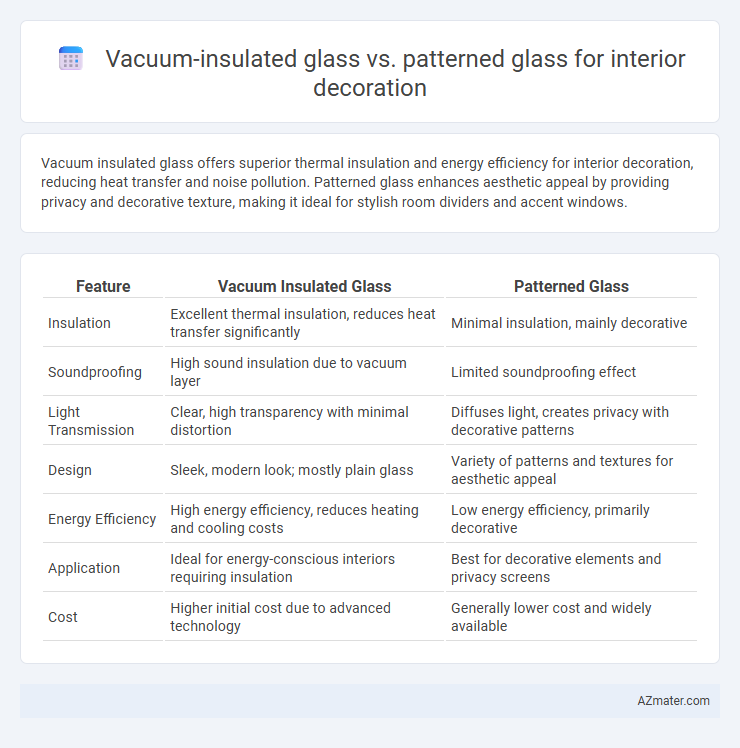Vacuum insulated glass offers superior thermal insulation and energy efficiency for interior decoration, reducing heat transfer and noise pollution. Patterned glass enhances aesthetic appeal by providing privacy and decorative texture, making it ideal for stylish room dividers and accent windows.
Table of Comparison
| Feature | Vacuum Insulated Glass | Patterned Glass |
|---|---|---|
| Insulation | Excellent thermal insulation, reduces heat transfer significantly | Minimal insulation, mainly decorative |
| Soundproofing | High sound insulation due to vacuum layer | Limited soundproofing effect |
| Light Transmission | Clear, high transparency with minimal distortion | Diffuses light, creates privacy with decorative patterns |
| Design | Sleek, modern look; mostly plain glass | Variety of patterns and textures for aesthetic appeal |
| Energy Efficiency | High energy efficiency, reduces heating and cooling costs | Low energy efficiency, primarily decorative |
| Application | Ideal for energy-conscious interiors requiring insulation | Best for decorative elements and privacy screens |
| Cost | Higher initial cost due to advanced technology | Generally lower cost and widely available |
Introduction to Vacuum Insulated Glass and Patterned Glass
Vacuum insulated glass (VIG) features two glass panes separated by a vacuum layer, providing superior thermal insulation and energy efficiency compared to traditional glazing. Patterned glass, characterized by textured or embossed surfaces, enhances privacy and aesthetic appeal through decorative patterns while diffusing light. Both glass types offer unique benefits for interior decoration, with VIG emphasizing performance and patterned glass focusing on visual and tactile design elements.
Key Differences Between Vacuum Insulated and Patterned Glass
Vacuum insulated glass (VIG) offers superior thermal insulation by creating a near-vacuum space between glass layers, significantly reducing heat transfer compared to patterned glass, which primarily serves aesthetic and privacy purposes with its textured surfaces. VIG enhances energy efficiency in interior spaces by minimizing thermal conductivity and condensation, while patterned glass provides decorative appeal and diffuses light without notable insulation benefits. The choice between VIG and patterned glass depends on the priority of energy performance versus visual design in interior decoration projects.
Aesthetic Versatility in Interior Decor
Vacuum insulated glass offers sleek, modern aesthetics with its clear, uninterrupted transparency, enhancing natural light and providing a minimalist appeal ideal for contemporary interiors. Patterned glass introduces texture and visual interest through various designs, enabling creative diffusion of light and privacy while serving as a decorative focal point in diverse interior styles. Combining both materials allows designers to balance elegant clarity with artistic patterning, optimizing aesthetic versatility in interior decor.
Energy Efficiency Benefits in Interior Spaces
Vacuum insulated glass offers superior thermal insulation by minimizing heat transfer through its vacuum layer, significantly reducing energy consumption for heating and cooling in interior spaces. Patterned glass, while providing aesthetic privacy and diffusing natural light, lacks the advanced insulation properties of vacuum insulated glass, resulting in higher energy loss. Choosing vacuum insulated glass enhances energy efficiency by maintaining stable indoor temperatures and lowering utility costs in interior decoration applications.
Light Transmission and Privacy Features
Vacuum insulated glass offers superior light transmission rates, typically around 70-80%, allowing abundant natural light while maintaining excellent thermal insulation. Patterned glass provides varied privacy levels with its textured surfaces, diffusing light to reduce visibility but usually transmitting less light, typically 50-70%. For interior decoration, vacuum insulated glass is ideal for bright, open spaces requiring clarity, whereas patterned glass is preferable in areas prioritizing privacy with softer, diffused lighting.
Acoustic Performance and Sound Insulation
Vacuum insulated glass (VIG) offers superior acoustic performance and sound insulation due to its airtight vacuum layer, which minimizes sound transmission and enhances noise reduction compared to traditional glass types. Patterned glass, while providing privacy and decorative appeal, usually exhibits lower sound insulation properties because its textured surface and single-glass construction cannot effectively block or absorb sound waves. For interior decoration requiring high acoustic control, vacuum insulated glass is a more effective solution, ensuring quieter and more comfortable indoor environments.
Design Flexibility and Customization Options
Vacuum insulated glass offers superior design flexibility with its slim profile and excellent thermal insulation, allowing architects to create sleek, modern interiors without sacrificing energy efficiency. Patterned glass provides extensive customization options through various textures, patterns, and finishes that enhance privacy and aesthetic appeal while diffusing light uniquely. Both materials support diverse interior decoration styles, but vacuum insulated glass excels in integrating advanced performance with minimalist design, whereas patterned glass emphasizes decorative versatility.
Installation Considerations for Both Glass Types
Vacuum insulated glass requires precise installation with specialized framing systems to maintain its thermal performance and prevent air leakage, often necessitating professional expertise and tools. Patterned glass offers more flexibility during installation due to its single-pane nature and can be cut on-site to fit custom dimensions, making it suitable for diverse decorative applications. Both types demand careful handling to avoid surface damage, but vacuum insulated glass installations must adhere to strict alignment and sealing protocols to ensure long-term durability and efficiency.
Maintenance and Longevity Comparison
Vacuum insulated glass offers superior durability and lower maintenance compared to patterned glass, as its airtight seal prevents moisture buildup and reduces condensation, extending lifespan significantly. Patterned glass, while aesthetically versatile, is more prone to trapping dust and grime in its textured surfaces, requiring more frequent cleaning and careful upkeep. In terms of longevity, vacuum insulated glass maintains clarity and performance over decades, whereas patterned glass may degrade faster due to surface wear and difficulty in thorough cleaning.
Cost Analysis and Value for Interior Decoration
Vacuum insulated glass offers superior thermal insulation and soundproofing properties, making it a costlier option with long-term energy savings and enhanced comfort in interior decoration. Patterned glass, while more affordable upfront, provides aesthetic value through decorative textures but lacks the insulation benefits, potentially increasing heating and cooling expenses over time. Investing in vacuum insulated glass delivers greater value for interiors prioritizing energy efficiency and durability, whereas patterned glass suits budget-conscious projects emphasizing style.

Infographic: Vacuum insulated glass vs Patterned glass for Interior decoration
 azmater.com
azmater.com